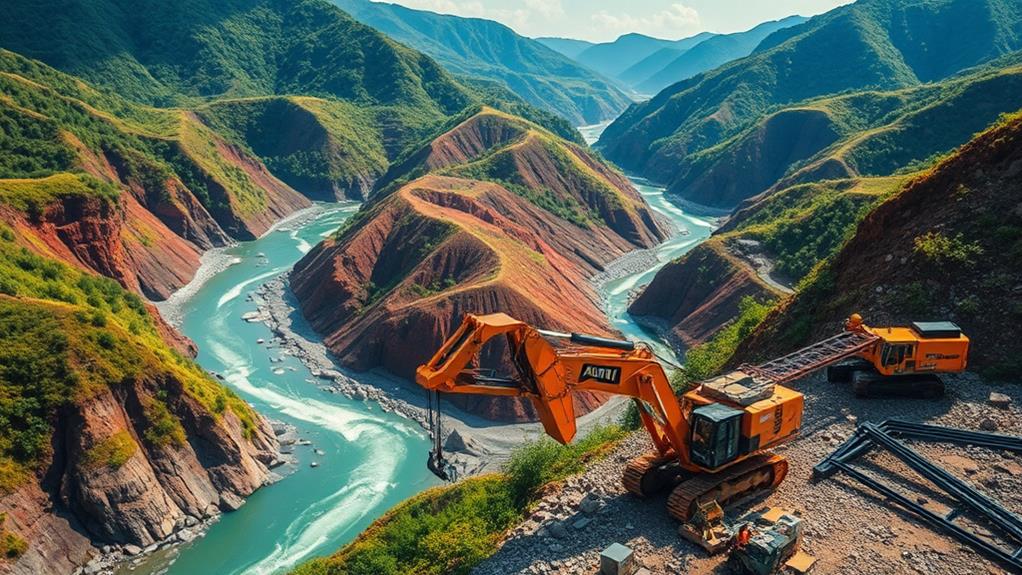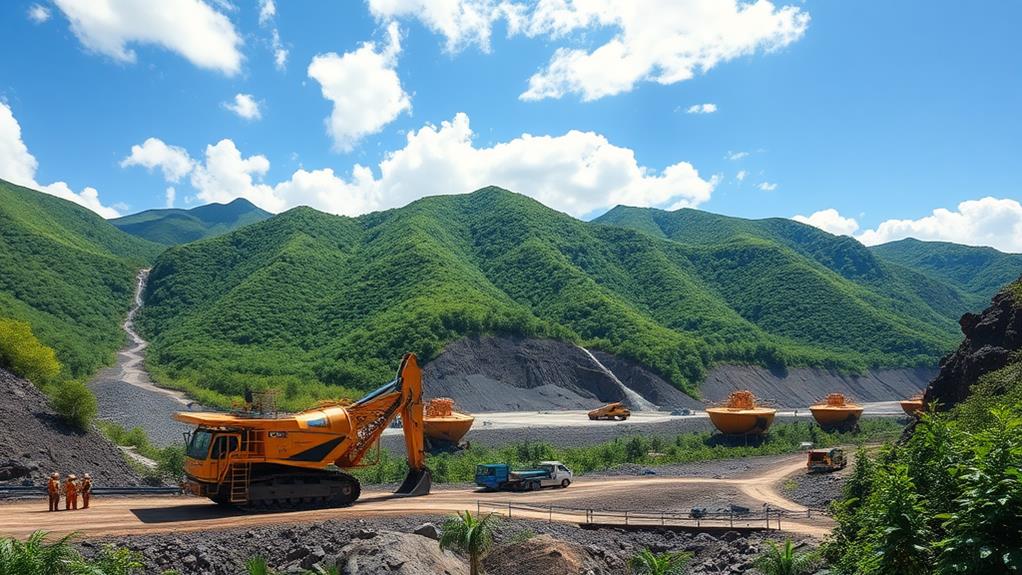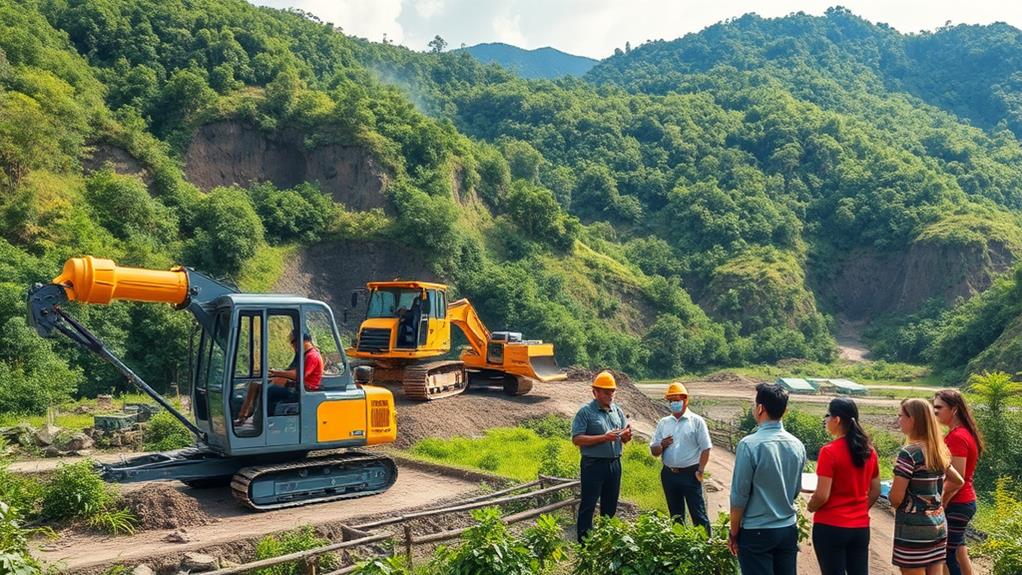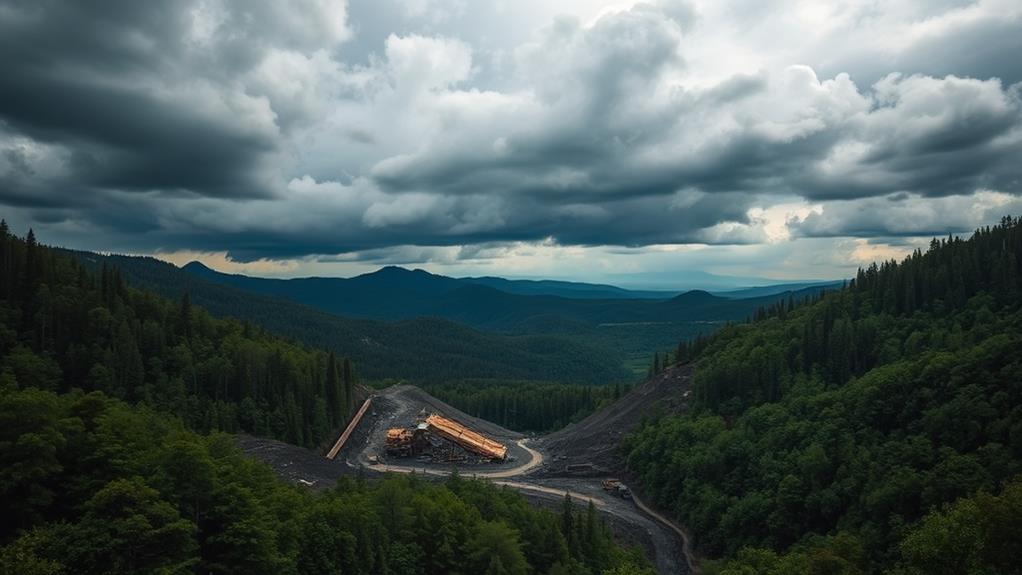The future of the mining industry in the Philippines appears promising due to approximately $1 trillion in untapped mineral resources. The country is becoming the second-largest nickel producer in the world, which may lead to more investments and higher production levels.
However, the regulatory environment presents challenges. It limits foreign ownership and requires detailed environmental assessments.
For example, major projects like the Silangan and Tampakan mines are expected to significantly increase output by 2025.
To address environmental issues, sustainability practices are crucial. These practices can help ensure that the industry benefits the economy while protecting the environment.
By understanding these factors, the mining industry can better navigate its challenges and maximize its potential.
Overview of Mineral Wealth

The Philippines has an estimated $1 trillion in untapped mineral resources, but only 5% of its mineral reserves have been explored. Currently, mining contracts only cover 3% of these reserves. This shows a big chance for growth in the mining industry. The country ranks fourth in the world for copper reserves and fifth for cobalt and nickel reserves.
There are 56 operating mines in the Philippines, which exported a total of $18.7 billion from 2020 to 2022. This represents 8.51% of the nation's total exports. This highlights the possible economic benefits of using its mineral resources.
In addition, metal production rose by 32% in 2022 compared to the previous year. This increase shows a growing interest in the mining sector. The untapped copper reserves and other minerals indicate that more exploration could lead to significant profits.
Regulatory Landscape
Navigating the regulatory landscape in the Philippines is essential for the mining industry. This landscape affects both investment and how mining operations function. The Department of Environment and Natural Resources (DENR) is responsible for enforcing environmental standards. They conduct thorough environmental impact assessments to ensure compliance.
Key points for investors include:
- Foreign Ownership Limitations: Foreign investors can own only 40% of mining permits. This rule aims to promote local companies while still allowing foreign investment.
- Environmental Compliance: Mining operations must provide detailed rehabilitation plans. These plans must show how they'll address any negative effects on the environment and local communities.
- Investment Attractiveness: The Philippines has a rich mineral wealth, but it ranks 72 out of 86 in global mining jurisdictions. This low ranking indicates that the regulatory environment can be challenging for investors.
Understanding these points is crucial for success in the Philippine mining sector.
Balancing regulatory compliance with efficient operations can lead to successful mining ventures in this resource-rich country.
Key Mining Projects

The mining industry in the Philippines is growing due to important projects. One major project is the Silangan project in Surigao del Norte, which will start operations in March 2025. This project is expected to increase mineral production in the area.
Another key project is the Tampakan copper/gold mine, which has large reserves of 15 million tons of copper and 17.6 million tons of gold. This makes it an essential part of future mining efforts.
The King-king copper-gold project is also significant, expected to recover 3.16 billion pounds of copper and 5.43 million ounces of gold. This highlights its economic importance.
The Mabilo gold/copper project has finished feasibility studies and drilling, indicating it's ready for investment.
Lastly, the Mankayan gold/copper mine has completed 62 technical drilling holes, showing strong potential for future mining.
Together, these projects demonstrate the Philippines' rich mineral resources and their role in promoting sustainable mining growth.
Production and Export Trends
The mining industry in the Philippines is growing and changing. In 2023, the Philippines became the world's second-largest nickel producer. This highlights the importance of this industry in providing nickel to meet global needs.
The country has about 10% of the world's nickel reserves, making it a major player in the market.
Here are three key trends in this sector:
- Total Export Value: From 2020 to 2022, the total export value of minerals was USD 18.7 billion, which is 8.51% of the Philippines' total exports. This shows how much minerals contribute to the economy.
- Operating Metallic Mines: The production of nickel and copper is expected to stay strong in the next few years. New mining projects are also expected to start by 2025. This will likely boost production even more.
- Environmental Impact: With increased production, the industry needs to focus on its environmental impact. It's important for mining companies to ensure they use sustainable practices to protect the environment.
These trends show how the mining industry in the Philippines is evolving and its role in the global market.
Government Policies and Support

Government policies significantly shape the future of the mining sector in the Philippines. The government promotes responsible extraction of critical minerals to ensure sustainable mining practices. For example, all mining sites must now conduct environmental impact assessments and create rehabilitation plans to protect the environment and support local communities.
Here are key policy initiatives:
| Policy Initiative | Objective | Impact on Industry |
|---|---|---|
| Responsible Extraction | Encourage sustainable practices | Attracts eco-conscious investors |
| Environmental Assessments | Ensure ecological preservation | Reduces environmental risks |
| Foreign Participation | Allow investments in renewable energy | Integrates mining with sustainability |
| Nickel Processing Boost | Enhance local value and jobs | Stimulates economic growth |
| Comprehensive Data | Minimize investment risks | Supports industry growth |
These policies lead to better environmental care and create jobs, helping the economy grow while protecting the planet.
Future Opportunities
The Philippines has $1 trillion in untapped mineral resources, with only 5% explored and 3% under mining contracts. This shows a lot of room for growth and investment in the mining sector.
Here are three areas of future opportunities:
- Nickel Production: The Philippines has 10% of the world's nickel reserves, ranking fourth globally. This is important because demand for nickel is increasing as industries move towards greener, sustainable practices.
- Investment in Processing Plants: The government is investing in processing plants to make the local mining industry more competitive. This creates jobs and adds value to raw materials, making it a smart choice for investors.
- Major Mining Projects: Projects like the Silangan project and the Tampakan copper/gold mine will greatly increase mining output. These efforts will attract both local and foreign investments, unlocking more potential in the sector.
Environmental Considerations

Environmental considerations are essential for the future of the mining industry in the Philippines. The government requires environmental impact assessments and rehabilitation plans for mining sites to ensure responsible extraction that protects ecosystems. This approach supports sustainable development, especially as the country focuses on improving its nickel processing sector with investments in processing plants.
Investors are increasingly looking at companies based on ESG (Environmental, Social, and Governance) criteria. This means companies must consider their impact on local communities and manage waste effectively. By implementing strong ESG practices, companies can align with sustainability goals and improve their social license to operate.
Additionally, the Philippine mining industry can play a crucial role in the country's energy transition. The goal is to reach a 50% share of renewable energy in the energy mix by 2040.
What are the potential challenges and opportunities for the future of the mining industry in the Philippines?
The future mining industry philippines faces both challenges and opportunities. Challenges include environmental concerns, regulatory changes, and community relations. However, opportunities exist in the form of technological advancements, increased demand for minerals, and potential economic growth for the country. The future mining industry Philippines has great potential for growth.
Investment Climate
The investment climate in the Philippines' mining sector has challenges but also great opportunities. The country currently ranks 72 out of 86 mining jurisdictions for attracting investment, showing it needs to improve to attract foreign investors.
However, there's an estimated USD 1 trillion in untapped mineral reserves, including important minerals like copper, gold, nickel, zinc, and silver.
Three key factors influence the investment climate:
- Limited Mining Contracts: Only 3% of the country's mineral reserves are covered by mining contracts. This indicates a large amount of potential for new investments and exploration.
- Government Initiatives: The government is making policies to support responsible mining and attract foreign investment. These changes can improve the investment climate significantly.
- Exploration Budget Recovery: The exploration budget was $35.3 million in 2022, showing a slight recovery from lower amounts in previous years. This suggests there's renewed interest in mining investments.
Challenges Ahead

The mining industry in the Philippines faces many challenges that affect its growth. The country is ranked 72 out of 86 mining jurisdictions, which makes it hard to attract foreign investment. Environmental scrutiny is increasing, leading to concerns from local communities and issues with waste management. These factors can slow down operations and deter further investment.
Despite having $1 trillion in untapped mineral reserves, only 5% has been explored. This shows that the mining sector is not fully developed. In 2022, the exploration budget was $35.3 million, which is much lower than the 2012 peak of $329.8 million. This indicates a slow recovery in the industry.
| Challenge | Impact on Investment | Future Opportunities |
|---|---|---|
| Regulatory complexities | Limits foreign investment | Potential for reform |
| Environmental regulations | Increases operational costs | Innovations in sustainability |
| Community opposition | Slows project timelines | Building local partnerships |
| Underexplored reserves | Missed economic potential | Growth in exploration |
Addressing these challenges is important for the Philippine mining sector to reach its full potential.
Questions and Answers
What Is the Status of Mining Industry in the Philippines?
The mining industry in the Philippines plays a key role in the economy. It contributes significantly to jobs and revenue. For example, mining provides employment for thousands of people and is a source of income for communities.
However, the industry also faces regulatory challenges. There are strict laws that aim to protect the environment. This means that mining companies must follow guidelines to reduce harm to nature. For instance, they must ensure that water sources are not polluted and that land is restored after mining activities.
To improve, the industry can adopt sustainable practices. This includes using technology that minimizes environmental impact. For example, some companies are now using advanced methods to reduce waste and improve efficiency.
What Is the Future of Mining Industry?
The future of mining will focus on sustainable practices and new technology. Companies will use cleaner methods to reduce environmental damage. For example, they might use electric vehicles instead of diesel ones to lower pollution.
Regulatory challenges will appear as governments create stricter rules to protect the environment. Mining companies will need to follow these rules closely.
Community engagement is important for success. Companies will work with local communities to gain support and address concerns. This can lead to investment opportunities, as people see the benefits of responsible mining practices.
What Is the Philippines Ranked in the Mining Industry?
The Philippines is ranked 72nd in the world for mining investment attractiveness. This ranking is influenced by various factors, including mining regulations, which can affect how easily companies can operate. For example, strict regulations may limit the areas where mining can occur. Additionally, economic impacts like job creation and revenue generation are important. Mining can bring jobs to local communities, but it can also lead to environmental concerns such as deforestation and water pollution. Finally, community engagement is essential; when local communities support mining projects, they are more likely to succeed. Overall, technological advancements may help improve the Philippines' position in the mining industry by making processes safer and more efficient.
What Are the Problems With Mining in the Philippines?
Mining in the Philippines faces serious problems. One major issue is environmental concerns. For example, mining can lead to deforestation and water pollution. Another problem is regulatory challenges. The laws governing mining are often unclear, making it hard for companies to operate responsibly.
Additionally, there are indigenous rights issues. Many indigenous communities are affected by mining operations, which often ignore their land rights. This leads to adverse community impacts, such as displacement and loss of livelihood.
All these factors have economic implications. They can hinder the industry's ability to develop sustainably, affecting not only miners but also local communities and the economy as a whole.